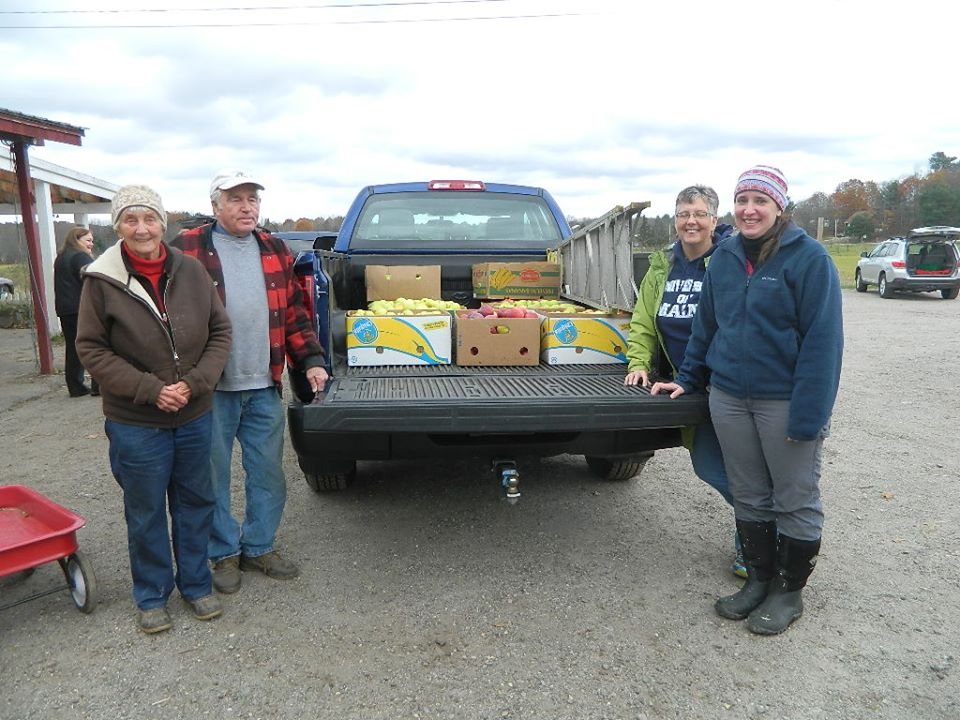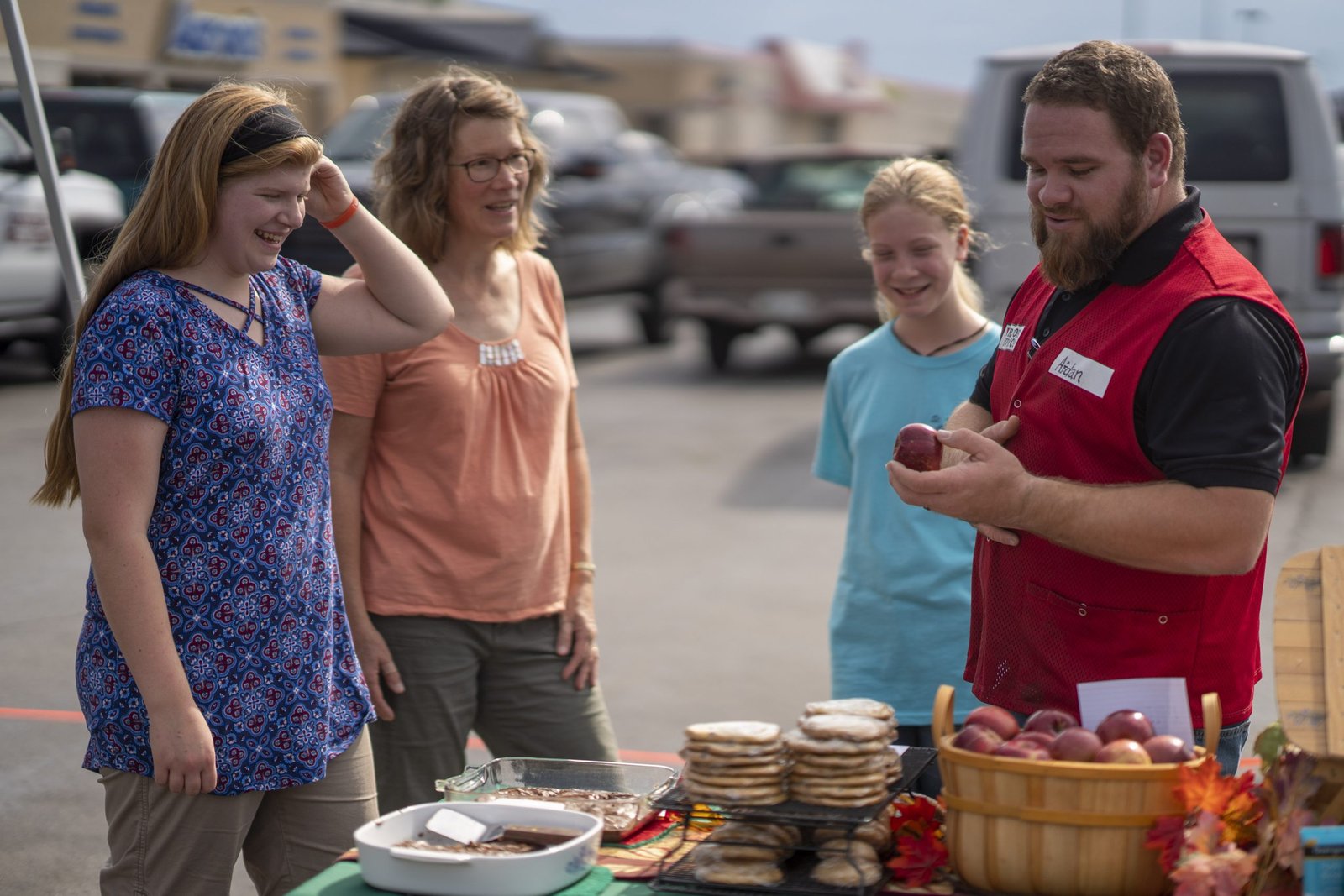As someone who grew up in a food-insecure household, I know what it’s like to be hungry. For much of my early childhood, our family relied on food stamps and subsidies for food. I remember my mom stretching everything as far as she could, and yet we still went to bed hungry many nights. She worked a lot, sometimes two jobs, but as a grocery store clerk, the money just wasn’t enough for our large family.
We did not have fresh fruit in the house very often, and when we did, my mom would beg me to not eat it all at once. I was so hungry for it that I sometimes did. I remember being thankful when the giant block of cheese arrived in our home, and again when we received a subsidy of a giant bottle of honey. I craved and treasured sweets, and the nectar made everything taste better.
The food insecurity of my childhood undoubtedly informed my decision to homestead as an adult in my adopted home of Maine. After working for years in academia, I decided to leave my full-time administrative job and work with my husband to grow our own food. We have chickens and ducks, and my husband grows an organic garden that supplies well over half of our family’s food for the year. I take pleasure in eating good, fresh, organic food, and I am grateful to have plenty of it. I am also thankful to have a hand in growing the food I eat—and for my journey into farming. It is because of this journey that I have come to detest waste; after all, I now deeply understand the work and resources that go into growing food.
What Is Gleaning?
After every harvest, my family participates in an activity called gleaning. For our family, gleaning involves going through our large, organic garden after we have processed all we can and then sharing what is left over with our friends and neighbors, as well as our chickens, who are gleaning experts.
But this is just our own version of gleaning. Gleaning is the age-old act of gathering leftovers after harvest. When food is harvested, some will always be left behind or missed, but frequently, food is left on the fields because it doesn’t meet grocery store standards for uniformity, even though the food is still good to eat. Gleaning, something that’s practiced all over the world, puts this leftover food to good use and provides to those in need. It both reduces waste and feeds the hungry.
It seems important to do anything we can to avoid waste, especially as our culture finally begins to understand how precious our resources are and just how much food waste really costs us. The rising costs at the grocery store have become a reminder of a harsh reality of changing climate. At the same time, many Americans are going hungry. It is estimated that one in eight Americans was food insecure in 2020.
The USDA estimates that about 30 percent of the food in America is wasted at the consumer and retail level. Research is still ongoing about how much food is wasted at the farm level, but a study published in 2019 found that more than 30 percent of crops on 123 farms in California were left behind, a number far larger than growers had estimated. Loss at the farm level is a particular problem for the produce industry. The USDA is working on solutions to help farmers with food loss at that level, and gleaning programs are an important part of this process.
In recent years, gleaning has become an organized effort in Maine, but the history of gleaning in the state runs much deeper, as does its history in Europe and other parts of the world. In fact, gleaning is mentioned in religious texts from many cultures. In Biblical texts, Hebrew farmers are commanded to leave some of their crops after harvesting for the poor. Perhaps because of this command, gleaning was an important part of life in Europe throughout the Middle Ages and into modern times. It took a specific court case in England in 1788 to legally end common laws protecting gleaning of private fields in that country.
And, for a time, it seemed gleaning rights would take a back seat to private property rights, particularly in the United States, but in other countries as well. Fortunately, laws in recent years have made it easier for the practice of gleaning to return. In 1996, the United States passed the Bill Emerson Good Samaritan Act, which limited liability for landowners, making it less risky to allow gleaners. Since then, the practice of gleaning has grown in key agricultural states across the country, including Maine.
The Great Gleaning Revival
Shortly after the passage of the Bill Emerson Good Samaritan Act, in 2000, the University of Maine Cooperative Extension launched Maine Harvest for Hunger, an organization focused on expanding access to food and reducing food waste from farms. Since its start over two decades ago, the program has donated more than two million pounds of food to those in need.
Maine Harvest for Hunger uses a variety of strategies to bring food to the food insecure. These strategies include sharing tables (where fresh produce is placed on tables and anyone can take from them without meeting certain income requirements that may exist for other programs for the food insecure), as well as farms dedicated to growing food for the hungry, such as Twin Villages Foodbank Farm and Growing to Give Farm.
Yet gleaning remains an important part of the equation. “Every farmer, no matter how big or how small, gets to the point where they have more than they can use,” says Lynne Holland of the University of Maine Cooperative Extension. Gleaning is one way to take advantage of this.
Similarly, the Maine Gleaning Network, which emerged in 2015, has helped make a substantial impact on reducing food waste. More loosely organized, the network is an umbrella group for 10 smaller gleaning networks in the state of Maine. Organizers focus on regional volunteers, to ensure gleaners do not have far to travel, and connect volunteer gleaners with farmers who are willing to allow gleaning. According to the network, gleaners in Maine harvested more than 400,000 pounds of food in 2021 for those facing food insecurity.

Gleaning in Maine has deeper roots with individual gleaners that go back generations. Katie Sprague from Hancock County is one of those gleaners. Her grandparents and parents were gleaners, and now she gleans as well. “I grew up gleaning,” she says. “We were a large family with a small income, and gleaning helped keep us fed.”
Her family mostly gleaned potatoes, but Sprague also has memories of gleaning strawberries and dropped apples. Later in her life, she also lived in Down East Maine, which is blueberry territory. “We used to go through after the blueberry fields were raked and pick what we could put up for winter,” she says.
Today, she continues the tradition of gleaning, and usually gleans potatoes and dropped apples, although she has also been able to pick various squashes left on the vines. For Sprague, gleaning is a part of a lifestyle of tradition and frugality. “It’s just the tradition of making do with what’s available and utilizing everything you can. You learn that pretty quickly when you grow up poor,” she says. “Gleaning makes me feel connected to my ancestors, to my history, in a way that is hard to adequately explain. I get the feeling they are right there with me.”
I understand what she means. My great grandparents were homesteaders before I knew what homesteading meant. I knew they had survived the Great Depression thanks to their farming and gardening skills. My grandpa farmed, and my grannie “put up” food. She canned, made jam and quilted, and I admired all of it.
I also admired the artwork that hung in their home. I remember looking up at an impressionistic print of a painting of women in a field wearing dresses I thought were lovely—long, practical. The women were leaning over picking something, harvesting some sort of crop. At the time, I had no idea what the painting was or who the artist was or that there was a difference between a harvest and a glean, but the print made an impression on me.
Later in my life, while I was in college, I was reminded of that painting when I saw a photograph of my grandparents with the print that had mesmerized me as a child in the background. I spent weeks researching the print by its description, which was no easy task in the days before Google. The painting, to me, exemplified my grandparents and represented something I was somehow longing for in my life—only I didn’t know it yet.
I figured out that the artwork was a reproduction of “The Gleaners,” a work by French artist Jean-François Millet. The painting depicted peasant women gleaning stray stalks of wheat after a full harvest. Millet, a French Impressionist known for his depictions of the lower classes in his paintings, revealed this work in 1857 to heavy criticism. Apparently, in a time so close to the French Revolution, the upper classes didn’t appreciate peasant life being depicted so openly. “The Gleaners” was a painful reminder of the reality of poverty and hunger.

“The Gleaners” by
Jean-François Millet.
I am thankful to live in a state with organized efforts to avoid food waste and feed its people. One of my favorite things about Maine is the frugality and practicality that permeates the culture here, and there is great respect given to those who know how to make the most of resources available. Sprague says farmers are very open to gleaners. “My experience is that most farmers are more than happy to let you pick over their fields, especially if you’re respectful to their land,” she says.
From organized gleaning organizations to small farmers allowing families to glean small plots from their farms and homesteads, this ancient practice of “sharing the leftovers” is alive and well here in Maine and other states—as it should be everywhere.
This year, after putting up 40 quarts of sauce—enough for our family for the year plus some gifts—we had a good 75 pounds of sauce tomatoes left over. I posted a note on social media to local friends, announcing that we had pounds of organic tomatoes to give away for free. Friends and acquaintances formed a virtual line, and all the tomatoes were picked up within a day.
It’s a good thing, too. I don’t want anything to go to waste. After years of growing food with my husband, I have seen the work, water and other resources that go into growing food. To waste all that while people go hungry feels unnecessarily tragic to me.
!function(f,b,e,v,n,t,s)
{if(f.fbq)return;n=f.fbq=function(){n.callMethod?
n.callMethod.apply(n,arguments):n.queue.push(arguments)};
if(!f._fbq)f._fbq=n;n.push=n;n.loaded=!0;n.version=’2.0′;
n.queue=[];t=b.createElement(e);t.async=!0;
t.src=v;s=b.getElementsByTagName(e)[0];
s.parentNode.insertBefore(t,s)}(window, document,’script’,
‘https://connect.facebook.net/en_US/fbevents.js’);
fbq(‘init’, ‘264217957779476’);
fbq(‘track’, ‘PageView’);












